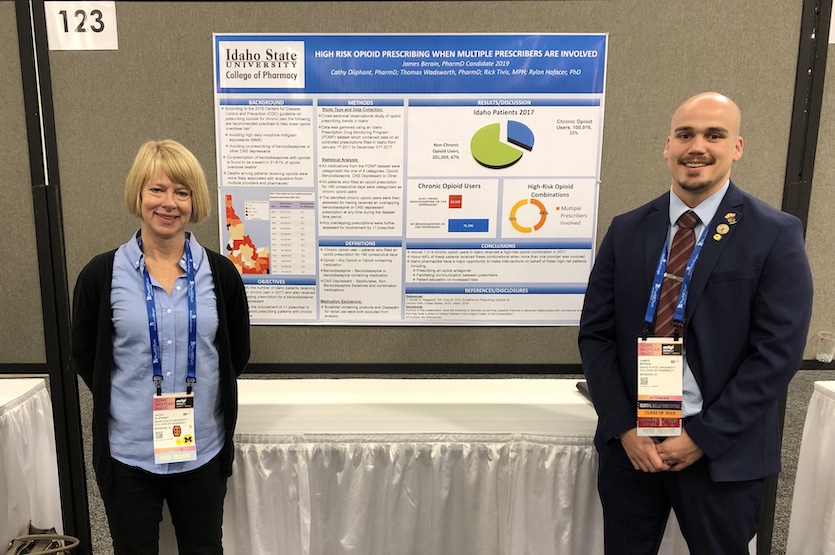Idaho State University study reveals dangerous prescribing practices for Idaho patients on opioids
December 11, 2018

A quarter of chronic users received high-risk drug combinations
MERIDIAN — Researchers at Idaho State University have found that one quarter of chronic opioid users in Idaho were at risk for overdose from unsafe combinations of prescriptions for controlled substances in 2017. Dr. Catherine Oliphant, a professor of pharmacy practice at ISU, served as faculty advisor for the study, led by Doctor of Pharmacy (PharmD) candidate James Berain. The two presented their findings at the American Society of Health-System Pharmacists (ASHP) Midyear Clinical Meeting and Exhibition in Anaheim, California on December 4. Their research shows that forty-four percent of the dangerous overlapping prescriptions were written by more than one prescriber.
“Patients with chronic pain are often under the care of several different physicians” said Oliphant, who initially became involved with opioid research in Idaho in 2009. “This co-management can lead to patients receiving unintentional prescription combinations that put them at higher risk for an opioid overdose.”
Of these dangerous combinations, the study found that fifty-six percent were written by the same prescriber. These results suggest that continued education on appropriate opioid prescribing is warranted, Oliphant said. “Individuals need to start the conversation with family and friends and become educated. Patients must become educated so that they can advocate for themselves - talk to your providers and pharmacists and ask questions. Are there non-opioid medications that I can use? Are there non-pharmacologic measures that can be used instead or in conjunction, such as physical therapy or massage? What are the signs and symptoms that someone might be misusing or overdosing? Ask about naloxone, which is used to help treat an opioid overdose.”
For this study, Berain and Oliphant examined all prescriptions of controlled substances for 301,975 patients that were reported to the Idaho Prescription Drug Monitoring Program (PDMP) in 2017. Anyone who dispenses these medications (including pharmacists, and some physicians as well as other clinicians) is required to report the dispensing record to the PDMP. The PDMP is a valuable resource that allows physicians and other prescribers to access patient records before writing new prescriptions to guide prescribing and above all, to help ensure patient safety. Though prior review of the PDMP is not required before prescribing, access to the PDMP is available in every state and the District of Columbia.
Berain and Oliphant’s study also found that a third of the patients receiving opioids were identified as chronic users, meaning they have taken opioids for more than 90 days without a break of at least seven days. Nearly one-quarter of those chronic users were also prescribed benzodiazepines (medications used for their sedative or anxiolytic properties) or other central nervous system (CNS) depressants — combinations the Centers for Disease Control and Prevention warn against because of the potential for overdose.
Oliphant considers herself a patient advocate, working not only to educate student pharmacists, such as Berain, at the ISU College of Pharmacy on best practices for prescribing opioid medications, but also taking her work into the communities of Idaho. She was involved in thestrategic planning and implementation with the Idaho Office of Drug Policy, Idaho Opioid Misuse and Overdose Workgroup, and the Treasure Valley Opioid Response Workgroup. She says pharmacists are in a key position to help identify patients who may be at risk. “Pharmacists can facilitate communication between prescribers, educate patients on the risks of the dangerous drug combinations, and prescribe an opioid-reversal agent such as naloxone.”
Oliphant hopes to share the message that the opioid epidemic doesn't discriminate, saying, “If you start a conversation with someone, you will likely find that someone close to them either takes or misuses an opioid or that a loved one has had an overdose/death due to [prescription] opioids or heroin. The opioid crisis is prevalent in all communities in Idaho.”
In Ada County, the coroner describes many of the Idaho drug-related deaths to be in those aged 40-50, often involving the working, middle class.
More information about Oliphant’s work surrounding the prescribing practices and treatment methods for opioid addiction can be seen in a recent interview on Channel 6 KIVI in Boise. Visit: https://www.kivitv.com/finding-hope.
